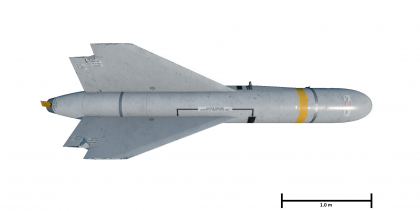AGM-62A Walleye I ER (510 kg)
| This page is about the "extended-range" AGM-62A Walleye I ER (510 kg). For the original TV-guided munition of the same designation, see AGM-62A Walleye I (505 kg). |
Contents
Description
The AGM-62A Walleye I ER is an American guided bomb for aircraft use. It is one of the first guided bomb introduced into War Thunder in Update "Ground Breaking".
Vehicles equipped with this weapon
General info
| Bomb characteristics | |
|---|---|
| Guidance | TV |
| Mass | 510 kg |
| Explosive mass | 201.8 kg |
| Explosive type | Composition B |
| TNT equivalent | 264.36 kg |
The Walleye is physically large, as big as a the 2,000 lb LDGP Mk 84 bomb. This is due to the guidance system in the ordnance, with the explosive amount more analogous to a 1,000 lb bomb. In fact, the design makes the ordnance look like a missile, though it would be a misnomer to label it as such since it does not contain any of its own propulsion, simply gliding itself to the locked-on target.
Effective damage
As mentioned earlier, the explosive amount in the Walleye is closer to equivalent to the 1,000 lb LDGP Mk 83 bomb. The Walleye contains a TNT equivalent of 264.36 kg in its warhead, compared to the LDGP Mk 83's 272.43 kg TNT equivalent. However, the combat multiplier is much higher than a LDGP Mk 83 due to the TV guidance in the Walleye, allowing precise targeting of ground targets from a high-altitude.
Comparison with analogues
Give a comparative description of bombs that have firepower equal to this weapon.
Usage in battles
The AGM-62 has a TV guidance system similar to the AGM-65 missile. It is best used against ground targets, moving or static. However, the AGM-62 can also lock positions on the ground making it difficult to determine when the guidance system has locked onto a vehicle/target or the position near the vehicle/target. This is an issue for ground realistic battles where a target may stop and start moving at any moment making it important that the vehicle/target is being tracked, and with no way to determine whether the target is locked or the position is locked for a stationary target, it can make these weapons very annoying to use in ground RB.
Pros and cons
Pros:
- Good for precision drops on static targets and can lock onto moving targets
- Bomb payload is large enough for close hits to do devastating damages to ground targets.
Cons:
- Locking onto moving targets can be difficult due to distance and/or ground obstructions
- Cannot be dropped without lock
- Struggles to lock targets in dark environments (night)
History
Examine the history of the creation and combat usage of the weapon in more detail than in the introduction. If the historical reference turns out to be too long, take it to a separate article, taking a link to the article about the weapon and adding a block "/History" (example: https://wiki.warthunder.com/(Weapon-name)/History) and add a link to it here using the main template. Be sure to reference text and sources by using <ref></ref>, as well as adding them at the end of the article with <references />.
Media
Excellent additions to the article would be video guides, screenshots from the game, and photos.
See also
External links




